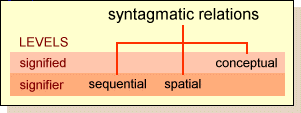Lesson 5: Syntagmatic Analysis
Syntagmatic Relations
Syntagms are combinations of signs.
 Syntagms are often defined as 'sequential' (and thus temporal - as in speech and music), but they can also represent spatial relationships.
Spatial syntagmatic relations are found in drawing, painting and photography.
Many semiotic systems - such as drama, cinema, television and the world wide web -
include both spatial and temporal syntagms.
Syntagms are often defined as 'sequential' (and thus temporal - as in speech and music), but they can also represent spatial relationships.
Spatial syntagmatic relations are found in drawing, painting and photography.
Many semiotic systems - such as drama, cinema, television and the world wide web -
include both spatial and temporal syntagms.
Syntagmatic Forms
Whilst narrative is based on sequential (and causal) relationships
(e.g. in film and television narrative sequences), there are also syntagmatic forms
based on spatial relationships (e.g. montage in posters and photographs,
which works through juxtaposition) and on conceptual relationships
(such as in exposition or argument).
The distinctions between the modes of narrative, description, exposition
and argument are not clear-cut (Brooks & Warren 1972, 44). Many texts contain more than one type of syntagmatic structure, though one may be dominant.
Exposition relies on the conceptual structure of argument or description.
Briefly, the structure of an
argument is both serial and hierarchical. It involves three basic elements:
- a proposition or series of propositions;
- evidence;
- justifications.
|
Class assignment 1 (group work, done orally):
Comment upon the following extract as an example of creating a syntagm.
Class assignment 2 (group work, done orally):
1. Look at picture 1 and answer the questions:
- How many syntagms can you observe?
- Can you see the complete syntagms or only parts?
- What is/are the relationship/s among these syntagms?
- Are these relations explicit or implicit?
- How many of the syntagms are you going to analyse?
- What form has the syntagm under analysis got?
- What type of relation combines its elements? Is it defined by genre?
- What is the meaning of this syntagm? Is it influenced by the type of relation among its elements?
2. Analyze picture 2 and decide whether its syntagm has got similar meaning.
(Don't forget that "the medium has a message".)
|
Resources for Lesson 5:
Chandler, Daniel. Semiotics for Beginners.
Student Essays (Daniel Chandler's course)
Brooks, Cleanth & Robert Penn Warren (1972): Modern Rhetoric (Shorter 3rd Edn.). New York: Harcourt Brace Jovanovich
Tolson, Andrew (1996): Mediations: Text and Discourse in Media Studies. London: Arnold
http://www.teamsputnik.co.uk/blog/CategoryView,category,Little%2BRed%2BPolitically%2BCorrect%2BRiding%2BHood.aspx
http://justfad.blogspot.com/2008_08_01_archive.html
|
Пермский государственный университет
|